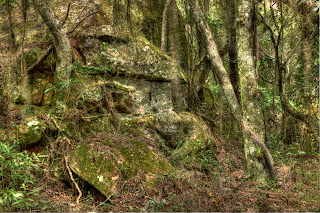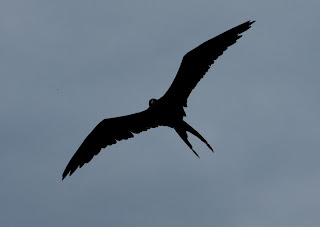Off to Nancite, down the road that scares even our talented driver Eladio and the only place he’s ever been stuck in the mud. Now it’s the dry season but it’s still a tough drive as you can see from the wall of water rising over the hood of our Land Cruiser and the roadway that looks like a riverbed. Just imagine what this road is like in the wet season - in fact it's completely impassible by even the most heavy duty vehicles.
At one point we drove by a stingless bee colony, which we must have brushed because they swarmed into one of the cars. Although they don't sting, the have a nasty bite that contains a cocktail of nasty chemicals and all in all feels like a sting. Worst of all, they had a habit of getting tangled in your hair.
Finally we could drive no further, and we gathered for a group shot before
shouldering our packs and walking about 400 metres to the base of the ridge separating Nancite from
Naranjo Beach (site of the famous surfers' Witches Rock or Pena Bruja) to the south. As we began our ascent, we reminded each other to “Go slowly, take a lot of breaks, and carry a lot of water”. Everyone had a water bottle and Ash and Dan carried 6 litre plastic jugs of water as well. We first went straight up for half and hour, resting at the top of the ridge looking at a wonderful view of both Naranjo and Nancite. A "mirador", or scenic view, required a further climb. This was significantly higher up than the main ridge - in that red oval are four people from our group to give you some perspective on difference between the ridge and the mirador vantage points.
A few brave souls ventured up to that high point for even better views.


After taking in the vista and watering up, we continued the 8 km march down to the research station and beach.
On the north side of the ridge, the dry season has already come in force.
Finally, we arrived.
Once there it was time to unpack, relax, put wet stuff out to dry, find mosquito netting and have lunch.
Then out to the beach for some shooting. Nancite is a major nesting beach for many species of sea turtles, especially the Olive Ridley’s turtle. This is not a tourist beach, so it was covered with driftwood, crabs and seabirds, and the occasional sea turtle corpse - no one to "tidies up."
Nonetheless, the beach itself is wonderfully photogenic, especially at the north end, where the estuary full of mangroves and crocodiles communicates with the sea at high tide, and where waves crash up against the rocks. Photographing that end of the beach comes with an extra attraction - quicksand! The area where the estuary and the sea meet is saturated with water from below, and if you set up your tripod and stand in one spot for more than a few seconds, you find yourself slowly sinking.
About 4 pm, Carla, a volunteer researcher from
Colombia with a Master’s degree from
Puerto Rico, moved out to the beach to check two nests of turtle eggs that were ready to emerge. She and Susana, the cook, collected just over 100 live baby Olive Ridley’s turtles from the nests under the watchful eyes of the black vultures and cacaras lining up for the buffet.
The sea turtles were counted and put in a large bucket. As the sun began to set and the tide began to come in, each of us was invited to release 10 of the nestlings. Acutely aware of the hovering vultures and swooping frigate birds, we tried to follow the rules:
1) each nestling must be released at least 3 m from the sea to give them time to orient themselves; 2) we can watch from the sides or from behind, but not in front, as this would confuse them; 3) once you release a turtle, you cannot pick it up and re-orient it; and 4) you cannot interfere with anything, especially the predators lingering nearby. No more than 1 in a thousand baby turtles make it, which means it’s very likely none of the 102 nestlings we released today made it, however, the screen provided unconsciously by eight photographers at least gave them all a chance to make it into the water.
The nestlings were not the only things in motion on the beach, as we scrambled to get good "family photos" of "our" little turtles as they literally "left the nest."
Carla, Susana and Pablo, those for whom this is a lifetime commitment, professional and personal, these acts embody hope, anxiety and satisfaction.
As the baby sea turtles made their way to the ocean we were treated to a spectacular sunset
that continued to get better
and better
and eventually magnificent!
A perfect ending to a few amazing hours on the beach.
Dinner was followed by some of us collapsing asleep and others heading out to the beach. You cannot go to the beach except with red lights in your headlamps, so there was no shooting to speak of. Pablo and Ash saw a female Olive Ridley sea turtle (known as Lora locally) come ashore to nest. They also found several small crocodiles in the estuary, although none large enough to warrant crocodile wrestling :)
We were up early Saturday morning to hike back, repeating the same grueling 8 km. This time we began earlier and finished faster, but we were pretty pooped by the time we reached the cars. Off to Santa Rosa to pick up the remainder of our gear and then onto our final destinations of the trip, the La Cangreja (she-crab) waterfall, and the Hotel Guachipelin, a Spanish colonial hacienda turned into a resort on the slopes of the Rincon de la Vieja.
On the way, we stopped at the Tempesquito Restaurant for some lunch and cold drinks. Looking at the picture you’d think we were filming a Pepsi commercial.
The cool, inviting Tempesquito River and the 10 m high bridge were too tempting for Eladio to resist. Adding to the excitement, the bridge spanning the river is the busy Interamerican highway.
He needed a swim and went in spectacular fashion.
Eladio is definitely an entertainer!
After lunch we continued on to La Crangreja.
Costa Rica has undertaken a huge geothermal project in which they tap into heat energy of Rincon de la Vieja (an active volcano near
Liberia) by drilling sideways from outside the boundaries of the conservation area. In this way, both energy production and preservation of biodiversity can occur in the same place. At one point getting into the trail head for La Cangreja, we were partially diverted by a large pipeline going in, but eventually made our way to the trail. At another point, a large tree blocked the road. We cut that into manageable lengths with our machetes and cleared the way.
After a hot, strenuous 1km hike along the trail used by the Guardaparques (Park Rangers), we made it to the waterfall, which was worth the extra work it took to get there.
La Cangreja is spectacular fall of about 30 m high falling into a natural rocky bowl, which then drains along a rock-lined quebrada (stream) typical of this area.
We stayed as long as we could, but eventually had to leave as the sun began to set and we began to lose the light.
We finished the trip off at the Hacienda Guachipelin with hot showers and comfy beds. We had a group dinner, a few drinks, and good conversations. This BioPhoto Experience tour provided a unique opportunity to explore and photograph unspoiled areas of this beautiful country, and we all agreed that it was an overwhelming success.
We are all home safely now and in the coming weeks we will open up the Flickr page for participants of the
Costa Rica trip to display their photos. Please follow the Flickr link through the BPE homepage to view these amazing photos and feel free to provide comments
to the photographers. Please check the BPE site frequently for updates on future excursions.






























































